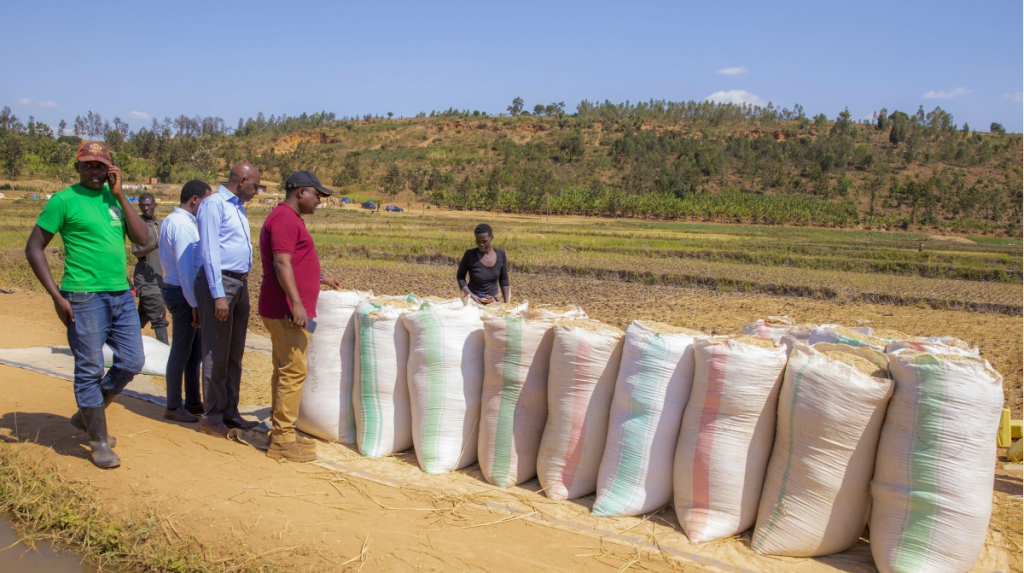Tags
Govt set to increase rice farming by 2,000ha in 2025.

Charles Nyandwi
Rwanda plans to expand its rice cultivation area by an additional 2,000 hectares, from 35,167 hectares in 2024 to approximately 37,167 hectares by the end of this year, according to Rwanda Agriculture and Animal Resources Board (RAB).
The expansion is among efforts to address the growing gap between rice demand and local production.
Rwanda’s rice imports jumped from 417,862 tonnes in 2023 to 508,852 tonnes in 2024, a 21 per cent rise.
The import bill soared from $238.9 million (approximately Rwf340.9 billion) to $317.2 million (approximately Rwf453.3 billion), a 32 per cent increase, according to the Ministry of Trade and Industry.
National demand also rose sharply, from 504,649 tonnes in 2023 to 596,938 tonnes in 2024. Despite this growth, local production met only 17 per cent of the national requirement in 2024, a drop from 22 per cent the year before.
Innocent Ndikumana, a Senior Researcher at RAB, told The New Times that the government’s plan to expand rice farming by 2,000 hectares across Gisagara, Gatsibo, Nyagatare, and Rusizi districts.
“In 2024, 35,167 hectares were already under rice cultivation, yielding 141,932 tonnes, a 6.2 per cent increase from the 133,628 tonnes recorded in 2023,” he noted.
New rice varieties
To support the expansion and improve productivity, “three new rice varieties are set to be introduced, pending certification by the Rwanda Inspectorate, Competition and Consumer Protection Authority (RICA).”
Among them is Keza, an aromatic variety expected to yield up to six tonnes per hectare. Keza,Ndikumana said, is expected to replace Basmati, which has been producing just two to three tonnes per hectare.
He explained that Keza shares similarities with Tanzanian varieties, but is a medium-length grain.
Two additional varieties, TETA 24-1 and TETA 24-2, are also awaiting certification. These long-grain varieties are projected to yield between 7 and 8 tonnes per hectare and are best suited for mid-altitude regions in the Southern and Eastern provinces, such as Rwamagana, Kayonza, Gatsibo, and Nyagatare.
“We could receive the certification this month or any time now. It has already been tested, and once approved, farmers will be able to cultivate it in the next season, which begins in July,” he noted
“Farmers are currently earning between Rwf450 and Rwf500 per kilogram of paddy rice,” Ndikumanaadded, citing the impact of strong market demand and agricultural incentives.
The government currently supports rice farmers through subsidies and insurance schemes.
Rice is one of the crops covered under the fertiliser subsidy programme, with the state contributing 45 per cent of the cost for DAP, 32 per cent for UREA, 41 per cent for NPK 17-17-17, 30 per cent for Kynoplus (coated UREA), 36 per cent for KCL/MOP, and between 10 per cent and 46 per cent for micronutrient fertilisers and blends
Appolinaire Gahiza, farmer who grow rice in Rwamagana and Kayonza districts, said the land available for rice farming is still too limited.
“If, for example, I’m growing rice on 20 to 30 acres, while others are managing only 10, it shows how restricted the space is,” he said. “Increasing the available land could be a big boost, not just for us farmers, but for the country as well, by helping reduce rice imports.”
Gahiza pointed out that small-scale farmers often set aside significant investment, but still struggle with losses due to low yields.
Current rice varieties, such as Kigoli, produce about four tonnes per hectare, and there’s a need to shift to improved varieties that can yield closer to eight tonnes per hectare, he added.
https://www.newtimes.co.rw/article/26415/news/agriculture/govt-set-to-increase-rice-farming-by-2000ha-in-2025Published Date: May 14, 2025






